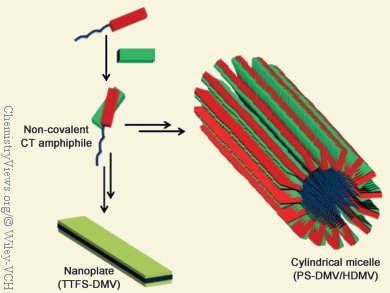Conducting nanowires of π-conjugated systems offer a lot of potential for flexible, organic electronics. Although self-assembly provides a simple bottom-up approach to construct these nanowires, the resulting nanowires often show poor conductivity. External doping is indispensable for improving their conductivity; however, for organic systems the doping is often not uniform throughout the sample.
To address these issues, Subi George and co-workers, Jawaharlal Nehru Centre for Advanced Scientific Research (JNCASR), Bangalore, India, utilized mixed stack charge-transfer (CT) assemblies as conducting nanowires. In this context, a non-covalent amphiphilic strategy was used for the design of CT nanowires, from the alternate co-assembly of amphiphilically designed donor (D) and acceptor (A) molecules. When perylene/TTF tetracarboxylate donors (see picture; green) are co-assembled with amphiphilic viologen acceptors (see picture; red) in water, CT nanostructures having extended cofacial D–A arrays are formed. These CT nanostructures showed impressive conductivity without any external doping.
The group is now trying to generalize this approach to various other π-systems and is exploring collaborations for the fabrication of state-of-the-art devices.
- Charge-Transfer Nanostructures through Noncovalent Amphiphilic Self-Assembly: Extended Cofacial Donor-Acceptor Arrays,
K. Venkata Rao, Krishnendu Jalani, K. Jayaramulu, Umesha Mogera, Tapas Kumar Maji, Subi J. George,
Asian J. Org. Chem. 2014, 3, 161–169.
DOI: 10.1002/ajoc.201300229


![Synthesis of [c2]Daisy Chains via Mechanochemistry](https://www.chemistryviews.org/wp-content/uploads/2025/04/202504_RotaxanesWithSolidStateMechanochemistry-125x94.png)

